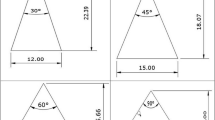Abstract
A computer code, ELANEX, including several Homogenous-Equilibrium-Model (HEM) type cavitation models, were developed, to numerically simulate natural cavitation phenomena. The effectiveness of the code was checked by cavitation flows around the disk and cylinder body for a wide range of different cavitation numbers. Cavity profiles were compared with the analytic solution of disk and empirical formulae fitted from the experiment data, and contrast between different cavitation models were fulfilled as well. The cavity length and maximal cavity diameter were found to agree well with the analytic solutions, and detailed cavity profiles were in accordance with the experimental formula. Comparison with the hemisphere headed cylinder body presented a good agreement of the pressure coefficient with the experiment data. Reasonable drag-force coefficient variation and drag-force reduction effect were obtained.
Similar content being viewed by others
References
MERKLE C. L., FENG J. and BUELOW P. E. O. Computational modeling of the dynamics of sheet cavitation[C]. 3rd Int. Symp. on Cavitation. Grenoble, France, 1998, 307–313.
BYEONG R. S., SATORU Y. and XIN Y. Application of Preconditioning method to gas-liquid two phase flow computations[J]. J. Fluids Engineering, 2004, 126(4): 605–612.
WU Lei, LU Chuan-jing and XUE Lei-ping. An approach in modeling two-dimensional partially cavitating flow[J]. Journal of Hydrodynamics, Ser. B, 2002, 14(1): 45–51.
WU Lei. Numerical simulations of cavitating flows[J]. Journal of Hydrodynamics, Ser. B, 2003, 15(4): 125.
WU Lei, LU Chuan-jing and LI Jie et al. Numerical simulations of 2D periodic unsteady cavitating flows[J]. Journal of Hydrodynamics, Ser. B, 2006, 18(3): 341–344.
CHEN Ying, LU Chuan-jing and WU Lei. Modeling and computation of unsteady turbulent cavitation flows[J]. Journal of Hydrodynamics, Ser. B, 2006, 18(5): 559–566.
KUBOTA A., KUTO H. and YAMAGUCHI H. A new modeling of cavitating flows: a numerical study of unsteady cavitation on a hydrofoil section[J]. J. Fluid Mech., 1992, 240(7): 59–96.
MARKATOS N. Modeling of two-phase transient flow and combustion of granular propellants[J]. Int. Journal of Multiphase Flow, 1986, 12: 913–933.
FU Hui-ping, LU Chuan-jing and WU Lei. Research on characteristics of flow around cavitating body of revolution[J]. Journal of Hydrodynamics, Ser. A, 2005, 20(1): 84–89(in Chinese).
KUNZ R., BOGER D. and CHYCZEWSKI T. et al. Multi-phase CFD analysis of natural and ventilated cavitation about submerged bodies[C]. 3rd ASME/JSME Joint Fluids Engineering Conference. San Francisco, CA, USA, 1999.
OBA R., IKOHAGI T. and YASU S. Supercavitating cavity observations by means of laser velocimeter[J]. J. of Fluids Engineering, 1980, 102: 433–439.
VLASENKO Y. D. Experimental investigations of high-speed unsteady supercavitating flow[C]. 3rd Int. Symp. on Cavitation. Grenoble, France, 1998, 2: 39–44.
KUKLINSKI R., HENOCH C. and CASTANO J. Experimental study of ventilated cavities on dynamic test model[C]. 4th Int. Symp. on Cavitation. California, USA, 2001.
SAVCHENKO Y. N. High-speed body motion at supercavitating flow[C]. 3rd Int. Symp. on Cavitation. Grenoble, France, 1998, 2: 9–13.
GARABEDIANT P. Calculation of axially symmetric cavities and jets[J]. Pac. J. Math., 1956, 6(4): 611–684.
LOGVI-NOVICH G. V. Hydrodynamics of flows with free boundaries[M]. New York: Halsted Press, 1973.
ROUSE H., MCNOWN J. S. Cavitation and pressure distribution, head forms at zero angle of yaw[R]. Studies in Engineering Bulletin 32, State University of Iowa, 1948.
Author information
Authors and Affiliations
Corresponding author
Additional information
Project supported by the National Natural Science Foundation of China (Grant No. 10372061) and the Doctor Foundation (Grant No. 20030248001)
Biography: CHEN Ying (1979-), Male, Ph. D.
Rights and permissions
About this article
Cite this article
Chen, Y., Lu, Cj. A Homogenous-Equilibrium-Model Based Numerical Code for Cavitation Flows and Evaluation by Computation Cases. J Hydrodyn 20, 186–194 (2008). https://doi.org/10.1016/S1001-6058(08)60045-1
Received:
Revised:
Published:
Issue Date:
DOI: https://doi.org/10.1016/S1001-6058(08)60045-1




